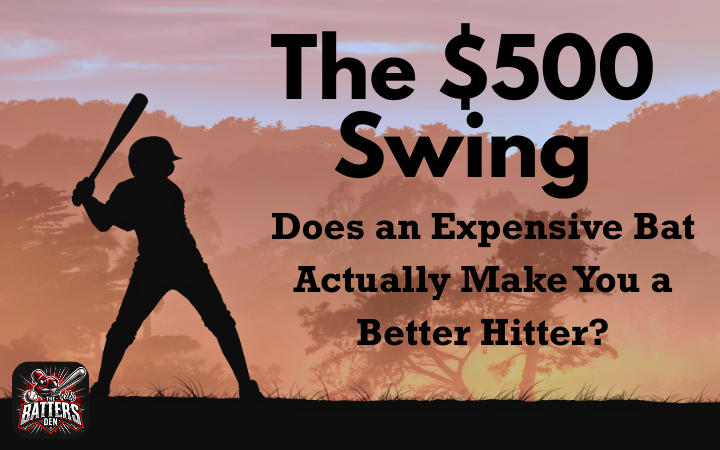
I was having a conversation the other day with a friend who was excited about the brand new, top-of-the-line, $500 bat he just bought for his grandson. He showed me the specs—it was a marvel of engineering, promising a bigger sweet spot, a faster swing speed, and more pop than ever before. He was sure this was the key to a breakout season.
And it got me thinking about one of the most debated questions in our sport: Does spending more money on a bat actually lead to more success on the field?
It’s a surprisingly controversial topic. On one side, you have players and parents who swear by the latest technology, believing every dollar spent is an investment in performance. On the other, you have old-school coaches who preach that it’s always the skill of the player that matters most.
As a facility that is 100% focused on developing hitters, not selling equipment, we feel we’re in a unique position to weigh in. So, let’s cut through the noise and give you a definitive, no-nonsense answer.
What Are You Actually Paying For?
First, let’s be fair. A $500 bat isn’t just expensive for the sake of it. You are paying for incredible technology and research. Companies spend millions to create bats with:
- Advanced Materials: High-grade composite fibers and aerospace-grade alloys that are lighter, stronger, and more responsive than basic aluminum.
- Complex Construction: Many high-end bats are two-piece models, where the barrel and handle are separate parts connected by a joint. This is designed to create more flex (whip) and dramatically reduce the sting from mishits.
- Precision Engineering: Every aspect is obsessed over, from the thickness of the barrel walls to the distribution of weight (balanced vs. end-loaded), all to push performance to the absolute legal limit of league standards like BBCOR or USSSA.
The Case for “Better Bat, Better Hitter”
So, does this technology translate to results? Sometimes, yes. Here’s the fair argument for investing in a high-end bat:
- The Forgiveness Factor: An advanced, expensive bat often has a larger and more forgiving sweet spot. For a developing hitter, this means a ball hit slightly off the end or near the hands might become a bloop single instead of a painful, vibrating out. This can be a real confidence builder.
- The “Pop” Factor: For a player who already has a good, efficient swing, the trampoline effect of a high-end composite bat is real. It can add a few extra feet to a well-struck ball, which can be the difference between a double off the wall and a home run.
- The Feel Factor: The vibration-dampening technology in two-piece bats makes a huge difference in feel. A player who isn’t afraid of getting their hands stung on a cold day is more likely to swing aggressively and with confidence.
The Counterargument: “It’s the Hitter, Not the Bat”
The points above are valid, but they don’t tell the whole story. Here’s where the argument begins to break down.
- The Law of Diminishing Returns: Is a $500 bat really $300 better than a solid, well-made $200 bat? For the vast majority of players, the answer is a clear and resounding no. The performance gain between a mid-range and a top-tier bat is marginal compared to the massive price jump.
- The Wrong Tool for the Job: This is a huge issue we see. A parent buys their 12-year-old an expensive, end-loaded bat designed for a college power hitter. The bat is too heavy, causing the player’s hands to drop, their swing to get long, and their bat speed to plummet. The “better” bat has actually made them a worse hitter by forcing them into bad mechanics.
- A Crutch, Not a Cure: This is the most important point. A high-tech bat cannot fix a flawed swing. It can’t teach a player to keep their hands inside the ball. It can’t fix bad timing. It can’t give a player a better approach at the plate. At best, its forgiving sweet spot might mask a problem, but it will never, ever solve it.
The Verdict: Our Definitive, No-Nonsense Conclusion
So, does an expensive bat make you a better hitter?
No. It does not.
A better hitter is what makes a bat perform. A player with a great swing will get results with a $150 bat. A player with a bad swing will still have a bad swing with a $500 bat. Skill is, and always will be, the number one factor in success.
Here’s our philosophy at The Batter’s Den: The single greatest investment you can make in your baseball or softball career is not in a piece of equipment, but in yourself. The cost of one top-of-the-line bat could pay for months of cage time or a series of lessons with a professional coach. That is an investment that delivers lasting, fundamental improvement that you take with you to the plate, no matter what bat is in your hands.
The “best bat” is not the most expensive one. It’s the one that is the correct length and weight for your size and strength. It’s the one that feels balanced in your hands. It’s the one that is legal for your league and, most importantly, fits your family’s budget.
Don’t buy a $500 solution for a swing problem. Invest in fixing the swing first. The results will follow.

